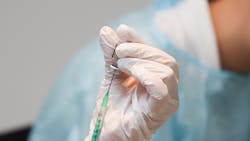Allergic reactions including anaphylaxis after Moderna COVID-19 vaccine first dose reported
Early safety monitoring of Moderna COVID-19 vaccine detected 10 cases of anaphylaxis after reported administration of 4,041,396 first doses of Moderna COVID-19 vaccine (2.5 cases per million Moderna COVID-19 vaccine doses administered) as well as cases of less severe nonanaphylaxis allergic reactions, based on U.S. data for Dec. 21, 2020–Jan. 10, 2021, reported the Centers for Disease Control and Prevention (CDC).
Anaphylaxis is potentially life-threatening and requires immediate treatment.
Locations administering COVID-19 vaccines should adhere to CDC guidance, including screening recipients for contraindications and precautions, having necessary supplies and staff members available to manage anaphylaxis, implementing recommended postvaccination observation periods, and immediately treating suspected anaphylaxis with intramuscular epinephrine injection.
Based on this early monitoring, anaphylaxis after receipt of Moderna COVID-19 vaccine appears to be a rare event; however, comparisons of anaphylaxis risk with that associated with non–COVID-19 vaccines are constrained at this time by the limited data available this early in the COVID-19 vaccination program. A previous analysis of the Pfizer-BioNTech COVID-19 vaccine, also an mRNA vaccine, estimated an initial rate of 11.1 cases per million doses administered after receipt of the first dose of the Pfizer-BioNTech vaccine. CDC and FDA will continue enhanced monitoring for anaphylaxis among recipients of COVID-19 vaccines and will review case reports to VAERS.
In nine of 10 cases of anaphylaxis after receipt of Moderna COVID-19 vaccine, patients had symptom onset within 30 minutes of vaccination, and nine anaphylaxis patients also had a history of allergies or allergic reactions, including some with previous anaphylaxis events; up to 30percent of persons in the general population might have some type of allergy or history of allergic reactions.
All 10 anaphylaxis cases reported after receipt of Moderna COVID-19 vaccine occurred in women. Whereas a previous review of anaphylaxis reports to VAERS found that 80 percent of cases reported in adults involved females, the current finding could be affected by the observation that more women than men had received a first dose of Moderna COVID-19 vaccine during the analytic period (61 percent of doses administered versus 36 percent, respectively).
In a previous analysis of the Pfizer-BioNTech COVID-19 vaccine, two thirds of first doses were administered in women. The clinical and epidemiologic characteristics of anaphylaxis case reports after receipt of Moderna COVID-19 vaccine are similar to those reported after receipt of the Pfizer-BioNTech COVID-19 vaccine. For both vaccines, symptom onset after vaccination occurred quickly, usually within minutes. A strong female predominance of anaphylaxis case reports exists for both vaccines. Finally, many persons experiencing anaphylaxis after receiving either vaccine had a history of allergies or allergic reactions, with several having experienced an anaphylaxis episode in the past. Similar patient characteristics in case reports of nonanaphylaxis allergic reactions were observed among the two vaccines.
Mortality from COVID-19 in populations at increased risk for severe illness is substantial, and treatment options are limited. Widespread vaccination against COVID-19 with highly effective vaccines represents a critical tool in efforts to control the pandemic and save lives. CDC and FDA will continue to monitor for adverse events, including anaphylaxis, after administration of COVID-19 vaccines and will regularly assess the benefits and risks of vaccination in the context of the evolving epidemiology of the pandemic.
Anaphylaxis is a life-threatening allergic reaction that occurs rarely after vaccination, with onset typically within minutes to hours. Among these case reports, 10 cases were determined to be anaphylaxis (a rate of 2.5 anaphylaxis cases per million Moderna COVID-19 vaccine doses administered), including nine in persons with a documented history of allergies or allergic reactions, five of whom had a previous history of anaphylaxis. The median interval from vaccine receipt to symptom onset was 7.5 minutes.
Among eight persons with follow-up information available, all had recovered or been discharged home. Among the remaining case reports that were determined not to be anaphylaxis, 47 were assessed to be nonanaphylaxis allergic reactions, and 47 were considered nonallergic adverse events. For four case reports, investigators have been unable to obtain sufficient information to assess the likelihood of anaphylaxis.
CDC guidance on use of mRNA COVID-19 vaccines and management of anaphylaxis is available. Persons with an immediate allergic reaction to the first dose of an mRNA COVID-19 vaccine should not receive additional doses of either of the mRNA COVID-19 vaccines. In addition to screening for contraindications and precautions before administering COVID-19 vaccines, vaccine locations should have the necessary supplies and trained staff members available to manage anaphylaxis, implement post-vaccination observation periods, immediately treat persons experiencing anaphylaxis signs and symptoms with intramuscular injection of epinephrine, and transport patients to facilities where they can receive advanced medical care. In addition, all patients should be instructed to seek immediate medical care if they develop signs or symptoms of an allergic reaction after their observation period ends and they have left the vaccination location.
Healthcare providers can play an important role in vaccine safety monitoring by being vigilant in recognizing and reporting adverse events after immunization to VAERS at https://vaers.hhs.gov/reportevent.html.
